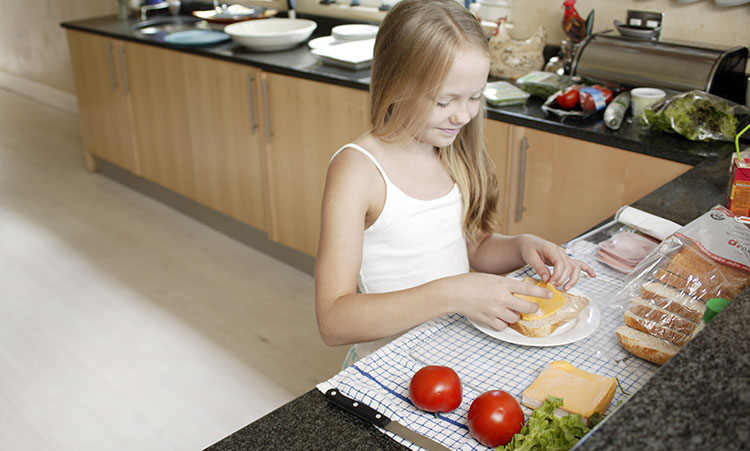C1: Introducing Sentences: Who It’s About
1. Overview
Learn what a sentence is and how it can be divided into two main parts. This is an introduction to the concept of spoken language being broken down into individual sentences and being able to identify the subject (the who it’s about) part of a sentence. This activity is introducing a new concept and also new terminology (sentence, who it’s about, what’s happening), so you want to do this activity several times over the course of a week (at least), to be sure your child really understands the lesson. Use these terms consistently throughout this module so your child does not get confused:- sentence
- who it’s about
- what’s happening

This is a sentence: “Sister is making a sandwich.”
The who it’s about part is Sister. The what’s happening part is is making a sandwich.
2. Materials
No materials are needed for this activity, but you will want to write down the sentences you make up, so that you can use them again in the next activity. ↑ Top3. Activity
Video: How to play Introducing Sentences: Who It’s About
Start by giving your child a simple explanation of what a sentence is. For example:
Adult: A sentence is a very little story. Again, a sentence is a little story. What is a sentence? Child: A little story. Adult: Yes. “A sentence is a little story.” Say that. Child: A sentence is a little story. Adult: That’s right. A sentence has two parts. It has a who it’s about part [hold up one finger] and a what’s happening part. [hold up a second finger] How many parts does a sentence have? Child: Two parts. Adult: Yes, a sentence has two parts. It has a who it’s about part and a what’s happening part. What are the two parts of a sentence? Child: Who it’s about, and, um… Adult: A sentence tells you who it’s about, and what’s happening. Say it with me. Adult & Child: A sentence tells you who it’s about, and what’s happening. Adult: One more time. What does a sentence tell you? A sentence tells you… Child: who it’s about, and what’s happening. Adult: Yes, a sentence tells who it’s about and what’s happening.Now you will have your child identify the who it’s about part of some simple sentences that you will make up with input from your child. Use the child’s name for the who it’s about part, or subject — kids love hearing their own name in a lesson. For the what’s happening part, use some concrete actions that the child enjoys.
Adult: Good job saying what a sentence tells. Now let’s make a sentence — a little story — about YOU! Tell me some things that you have fun doing. Child: Blowing bubbles! Adult: Okay, listen: “[Child’s Name] blows lots of bubbles outside.” What’s the little story — the sentence — I just said? Say the whole thing I just said. Child: “[Child’s Name] blows lots of bubbles outside.” Adult: Yes! That was my sentence — my little story. Can you tell me the who it’s about part of my sentence? The who it’s about part of my sentence was…NOTE: If the child struggles, repeat your sentence, emphasize the child’s name (the who it’s about part), and hold up one finger for each of the two sentence parts as you say them.
Adult: Yes! The who it’s about part of my sentence was [Child’s Name]. That’s YOU!Here are some more examples of sentences you can make up about your child:
- Logan swims at the pool.
- Logan plays with his dog.
- Logan zips up his coat.
- Mom’s cat sleeps under the table. [action verb, present tense]
- Stewart lost his green shoes. [action verb, past tense]
- Daddy ate a sandwich. [action verb, past tense]
- Our dog will bark at strangers. [action verb, future tense]
- Baby sister cries a lot! [action verb, present tense]
4. Confidence Builder
Use two-word sentences with clear action verbs:- Mom sings.
- Dad snores.
- Rover barked.
- Toilets flush.
- Ice melts.
5. Extension
Use sentences with several words in the who it’s about part:- Our little brown dog barked loudly.
- The new boy next door rides a bike.
6. Small Groups (2-5 children)
Lesson Objective: Children will be able to identify the two parts of a sentence and understand that a sentence is a little story. GELDS (Georgia Early Learning & Development Standards): CLL6.3d (Activities for this standard will be increased in difficulty to match children’s age.) Georgia Standards of Excellence: ELAGSEKSL2 Common Core State Standards: CCSS.ELA-LITERACY.SL.K.2 Additional Materials:- optional: photos of individual children in the class
Leave a Reply


6 Responses to “C1: Introducing Sentences: Who It’s About”
Michelle
I absolutely loved this activity. I can’t wait to use it in the classroom. Thanks for sharing.
Cris
Hey, I am a teaching assistant in a junior secondary school in Hong Kong. Some of my students have very poor understandings of English sentence concept. I will play this activity with them and let you know what will happen. I have one question, do you think teachers who teach English as a foreign language can play these activities with their students to enhance students’ phonemic awareness?
ADMIN – Hi Cris,
I think it’s a great idea to use these games with English Language Learners (ELLs)! Our curriculum was developed with native English speakers in mind, but we’d love to know how your students like it.
Soraya Quezada
I can’t wait until to use this in my next classroom!
Debbie
I love this activity.
Joy Baynes
Can I use this activity for son to understanding reading comprehension?
ADMIN – Hi Joy,
This could be used as an early reading comprehension exercise.
Liza Sabucido
This website has been very helpful to me as I am currently preparing a student going to grade 1 for an admission test. Thank you so much!